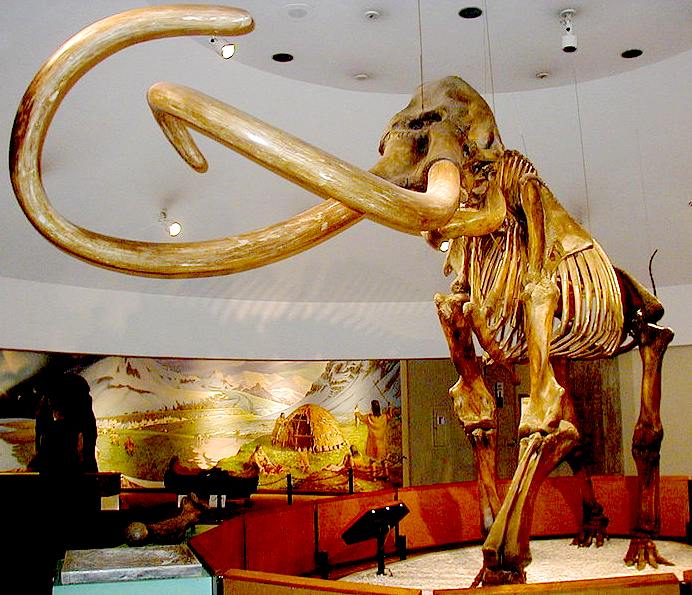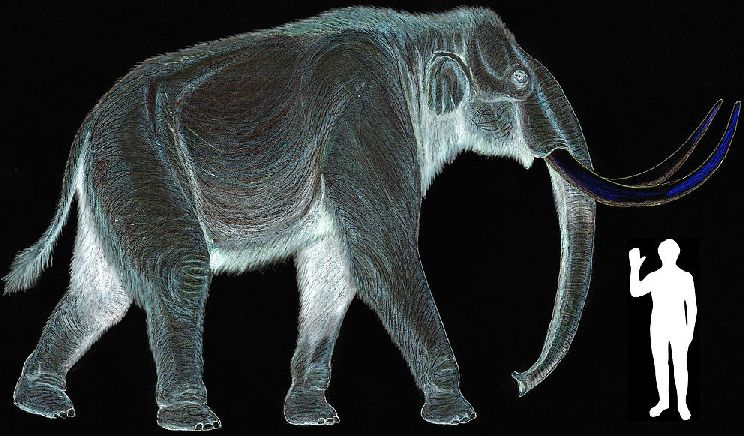|

A mammoth is any species of the extinct genus Mammuthus, proboscideans commonly equipped with long, curved tusks and, in northern species, a covering of long hair. They lived from the Pliocene epoch (from around 5 million years ago) into the Holocene at about 4,500 years ago in
Africa, Europe, Asia, and North America. They were members of the family Elephantidae which contains, along with mammoths, the two genera of modern elephants and their ancestors.
Like their modern relatives, mammoths were quite large. The largest known species reached heights in the region of 4 m (13 ft) at the shoulder and weights up to 8 tonnes (9 short tons), while exceptionally large males may have exceeded 12 tonnes (13 short tons). However, most species of mammoth were only about as large as a modern Asian elephant (which are about 2.5m to 3m high at the shoulder, and rarely exceeding 5.4 tonnes). Both sexes bore tusks. A first, small set appeared at about the age of six months and these were replaced at about 18 months by the permanent set. Growth of the permanent set was at a rate of about 2.5 to 15.2 cm (1 to 6 in) per year.
Based on studies of their close relatives, the modern elephants, mammoths probably had a gestation period of 22 months, resulting in a single calf being born. Their social structure was probably the same as that of African and Asian elephants, with females living in herds headed by a matriarch, whilst bulls lived solitary lives or formed loose groups after sexual maturity.
Scientists discovered and studied the remainders of a mammoth calf and found that the fat in a mammoth plays a major role to the mammoth's form and ability. One of the major roles of mammoth fat is their ability to store large amounts of nutrients to accommodate to the colder climate they live in. The fat also allowed the mammoths to increase their muscle mass, allowing the mammoths to fight against enemies and live longer.

EXTINCTION
The woolly mammoth (M. primigenius) was the last species of the genus. Most populations of the woolly mammoth in North America and Eurasia, as well as all the Columbian mammoths (M. columbi) in North America, died out around the time of the last glacial retreat, as part of a mass extinction of megafauna in northern Eurasia and the Americas. Until recently, the last woolly mammoths were generally assumed to have vanished from Europe and southern Siberia about 12,000 years ago, but new findings show some were still present there about 10,000 years ago. Slightly later, the woolly mammoths also disappeared from continental northern Siberia. A small population survived on St. Paul Island,
Alaska, up until 3750 BC, and the small mammoths of Wrangel Island survived until 1650 BC. Recent research of sediments in Alaska indicates mammoths survived on the American mainland until 10,000 years ago.
A definitive explanation for their extinction has yet to be agreed upon. The warming trend (Holocene) that occurred 12,000 years ago, accompanied by a glacial retreat and rising sea levels, has been suggested as a contributing factor. Forests replaced open woodlands and grasslands across the continent. The available habitat may have been reduced for some megafaunal species, such as the mammoth. However, such climate changes were nothing new; numerous very similar warming episodes had occurred previously within the ice age of the last several million years without producing comparable megafaunal extinctions, so climate alone is unlikely to have played a decisive role. The spread of advanced
human hunters through northern Eurasia and the Americas around the time of the extinctions was a new development, and thus might have contributed significantly.
Whether the general mammoth population died out for climatic reasons or due to overhunting by humans is controversial. During the transition from the Late Pleistocene era to the Holocene era, there was shrinkage of the distribution of the mammoth because of the progressive warming at the end of the Pleistocene era resulted in change in the mammoth's environment. The mammoth steppe was a periglacial landscape with rich herb and grass vegetation that disappeared along with the mammoth because of environmental changes in the
climate. Mammoths had moved to isolated spots in Eurasia, where they disappeared completely. Also, it is said that Late Paleolithic and Mesolithic human hunters may have affected the size of the last mammoth populations in Europe. There is evidence to suggest that humans did cause the mammoth extinction, although there is no definitive proof. It was found that humans living south of a mammoth steppe learned to adapt themselves to the harsher climates north of the steppe, where mammoths resided. It was concluded that if humans could survive the harsh north climate of that particular mammoth steppe that it was possible humans could hunt (and eventually extinguish) mammoths everywhere. Another theory suggests mammoths may have fallen victim to an infectious disease. A combination of climate change and hunting by humans may be a possible explanation for their extinction. Homo erectus is known to have consumed mammoth meat as early as 1.8 million years ago. This may mean only successful scavenging, rather than actual hunting. A site in Ukraine suggests Neanderthals built dwellings using mammoth bones. However, the
American Institute of Biological Sciences also notes bones of dead elephants, left on the ground and subsequently trampled by other elephants, tend to bear marks resembling butchery marks, which have previously been misinterpreted as such by archaeologists.
Another theory said to be the cause of mammoths in Siberia, comes from the idea that many may have drowned. While traveling to the Northern River many of these mammoths broke through the ice and drowned. This also explains bones remains in the Arctic Coast and islands of the New Siberian Group.
Dwarfing occurred with the pygmy mammoth on the outer Channel Islands of
California, but at an earlier period. Those animals were very likely killed by early Paleo-Native Americans, and habitat loss caused by a rising sea level that split Santa Rosae into the outer Channel Islands.
GENETIC RECREATION
As of 2014, there are ongoing projects such as that from Sooam attempting to
recover the mammoth population. Similar to the method popularised in the film Jurassic Park, the projects are based on finding suitable DNA in frozen bodies. The next step is to recover and, if possible, combine the
DNA with similar living animals such as the elephant, which may give birth to some mammoth-related or mammoth species.
DINOSAUR
LINKS | JURASSIC
PARK
Anthropology
| Archaeology | Dinosaurs
| Evolution | Fossils
| Geology | Mammoths
Meteorites | Paleontology
| Plate Tectonics | Neanderthal
Man
POPULAR
MAMMALS:

Evolution
accelerated by man
an
anthropological anthem by Jameson
Hunter
LINKS
http://en.wikipedia.org/wiki/Mammoth
http://en.wikipedia.org/wiki/Mammoth
OTHER
ANIMALS:
|
AMPHIBIANS |
Such
as frogs (class: Amphibia) |
|
ANNELIDS |
As
in Earthworms (phyla: Annelida) |
|
ANTHROPOLOGY |
Neanderthals,
Homo Erectus (Extinct) |
|
ARACHNIDS |
Spiders
(class: Arachnida) |
|
ARTHROPODS |
Crabs,
spiders, insects (phyla: Arthropoda) |
|
BIRDS
|
Such
as Eagles, Albatross
(class: Aves) |
|
CETACEANS
|
such
as Whales
& Dolphins
( order:Cetacea) |
|
CRUSTACEANS |
such
as crabs (subphyla: Crustacea) |
|
DINOSAURS
|
Tyranosaurus
Rex, Brontosaurus (Extinct) |
|
ECHINODERMS |
As
in Starfish (phyla: Echinodermata) |
|
FISH
|
Sharks,
Tuna (group: Pisces) |
|
HUMANS
- MAN |
Homo
Sapiens THE
BRAIN |
|
INSECTS |
Ants,
(subphyla: Uniramia class:
Insecta) |
|
LIFE
ON EARTH
|
Which
includes PLANTS
non- animal life |
|
MAMMALS
|
Warm
blooded animals (class: Mammalia) |
|
MARSUPIALS |
Such
as Kangaroos
(order: Marsupialia) |
|
MOLLUSKS |
Such
as octopus (phyla: Mollusca) |
|
PLANTS |
Trees
- |
|
PRIMATES |
Gorillas,
Chimpanzees
(order: Primates) |
|
REPTILES |
As
in Crocodiles,
Snakes (class: Reptilia) |
|
RODENTS |
such
as Rats, Mice (order: Rodentia) |
|
SIMPLE
LIFE FORMS
|
As
in Amoeba, plankton (phyla: protozoa) |
|
|
The
evolution of refreshment

Solar
Cola - a healthier alternative
|
